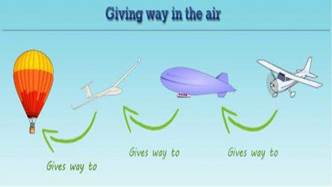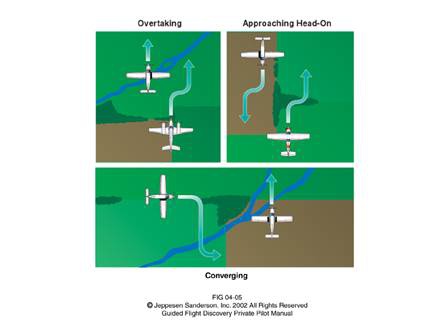

飛行優先通行權,一般是指某些情況下有優先飛行權的飛機的飛行規則。
一般來說,速度快的飛行器必須讓速度慢的先行;有動力的飛行器必須讓無動力的先行。依此原則,各種飛行器的空中優先權依次大致為熱氣球、滑翔機、飛船、輕型飛機、一般飛機等
就飛行狀況來說,兩個飛行器迎面相遇時,應各自向右轉彎避讓。而當兩個飛行器交會時,處於右側的飛行員擁有優先通行權,為此其他飛行員應向左或向右轉彎改變航線。同一方向飛行時.高度高的飛行員應讓高度低的先行。超越前方飛行員時.一般應由右邊超越,並應隨時注意前方飛行員的動態。前方飛行員有先行權。
或參考以下原文法規的說明:
§ 14 CFR 91.113 Right-of-way rules: Except water operations.
(a) Inapplicability. This section does not apply to the operation of an aircraft on water.
(b) General. When weather conditions permit, regardless of whether an operation is conducted under instrument flight rules or visual flight rules, vigilance shall be maintained by each person operating an aircraft so as to see and avoid other aircraft. When a rule of this section gives another aircraft the right-of-way, the pilot shall give way to that aircraft and may not pass over, under, or ahead of it unless well clear.
(c) In distress. An aircraft in distress has the right-of-way over all other air traffic.
(d) Converging. When aircraft of the same category are converging at approximately the same altitude (except head-on, or nearly so), the aircraft to the other's right has the right-of-way. If the aircraft are of different categories—
(1) A balloon has the right-of-way over any other category of aircraft;
(2) A glider has the right-of-way over an airship, powered parachute, weight-shift-control aircraft, airplane, or rotorcraft.
(3) An airship has the right-of-way over a powered parachute, weight-shift-control aircraft, airplane, or rotorcraft. However, an aircraft towing or refueling other aircraft has the right-of-way over all other engine-driven aircraft.
(e) Approaching head-on. When aircraft are approaching each other head-on, or nearly so, each pilot of each aircraft shall alter course to the right.
(f) Overtaking. Each aircraft that is being overtaken has the right-of-way and each pilot of an overtaking aircraft shall alter course to the right to pass well clear.
(g) Landing. Aircraft, while on final approach to land or while landing, have the right-of-way over other aircraft in flight or operating on the surface, except that they shall not take advantage of this rule to force an aircraft off the runway surface which has already landed and is attempting to make way for an aircraft on final approach. When two or more aircraft are approaching an airport for the purpose of landing, the aircraft at the lower altitude has the right-of-way, but it shall not take advantage of this rule to cut in front of another which is on final approach to land or to overtake that aircraft.


 留言列表
留言列表


 {{ article.title }}
{{ article.title }}